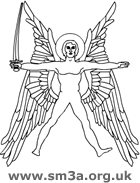News

As our Historic Tower restoration nears completion, a few last finishing touches are being added before the scaffolding comes down for the 'big reveal' towards the end of March.
Of course, none of this would have been possible without the generous support of the Heritage Lottery Fund, All Churches Trust, the Beds & Herts Historic Churches Trust, the Francis Coales Charitable Foundation, and the Steel Charitable Trust.
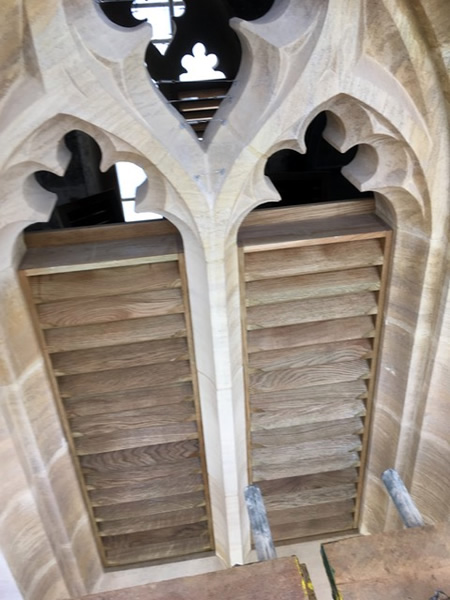
So, here are a couple of photographs of the new window louvres being installed this week, kindly sent to me by Patricia Goulding, our Churchwarden.
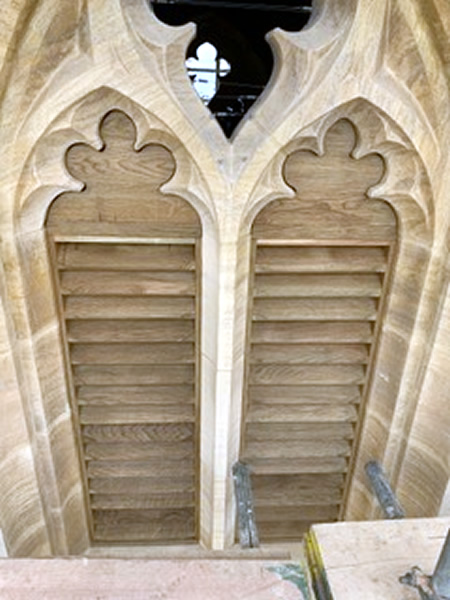
Photograph: Patricia Goulding
Author: Stephen Lines
Date: 9th March 2019
 Unlocking the church for the 8.30 Holy Communion service this morning, I was greeted by some significant changes.
Unlocking the church for the 8.30 Holy Communion service this morning, I was greeted by some significant changes.
We now have lighting again (Yay!!!), though only the high level ones and the new emergency lighting are connected at the moment - all wired to a small and discreet switch panel just inside the new lobby (all the new lights are LED and dimmable, so we can do 'mood' lighting for special events).
My last news item on the re-modelling of the entrance lobby left things on a bit of a cliff-hanger "what is the new lobby going to look like? You'll just have to wait and see...".
Well now you can!
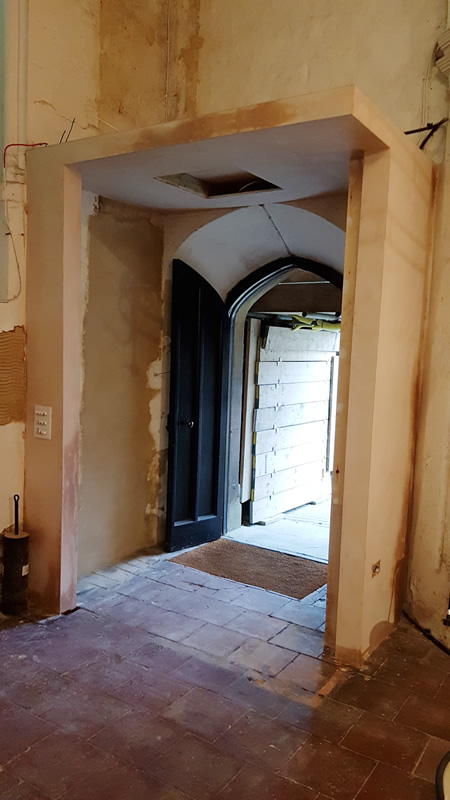
This is the 'solid' bit of the new lobby, which cleverly incorporates some extremely slim cupboards to house the electrics, and is so hot off the press that the plaster is not even dry yet.
It already feels more open and spacious, and I love the way that the new lobby highlights the curved hood over the door - I'd never even noticed it before. Ticks the 'welcoming' box for me so far.
You can also see the new 'tiny but clever' light switch panel on the left.
Patricia Goulding, our amazing Churchwarden informs me that the opening has been measured for the 'new glass' this week, so there's the next cliff hanger...
We WILL have to wait and see, but judging by everything I've seen so far on this mega-project, it will definately be worth waiting for!
Of course, none of this would have been possible without the generous support of the Heritage Lottery Fund, All Churches Trust, the Beds & Herts Historic Churches Trust, the Francis Coales Charitable Foundation, and the Steel Charitable Trust.
So, once again, a sincere 'thank you' to all of the funding bodies and people who have made this project turn from a dream into a plan, then into a reality that will benefit Shefford for generations to come.
You may remember reading about the removal of our clock so that it could be taken away for a full restoration by A.James of Saffron Walden. I've just been informed that the restoration work is finished, and that the clock face and hands have now been re-fitted on the tower.
The first photograph below shows the clock face and hands back in place on our (almost fully restored) tower - brilliant timing as the scaffolding is due to come down in a few days time.
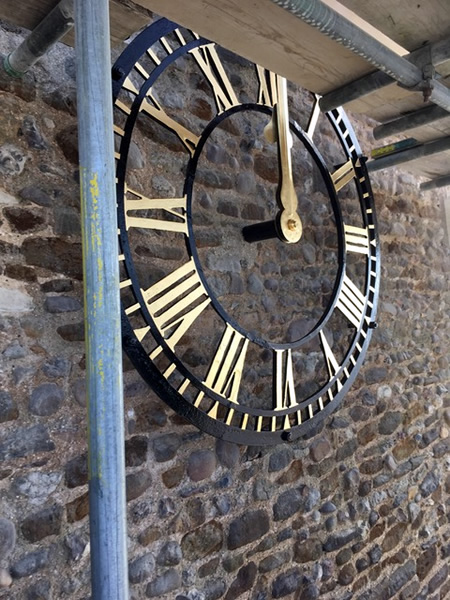
Observant readers will notice that the clock face is now black, with gold lettering (when it was removed, the face was blue). Research has discovered that black was the original colour, so as this is part of a Heritage driven restoration project, the opportunity was taken to restore the clock to it's original 'look'.
The main part of any clock is the mechanism - the bit that very few people ever see. This has also undergone a full restoration and is safely stored in the church, waiting for the clock chamber to be ready for its re-installation.
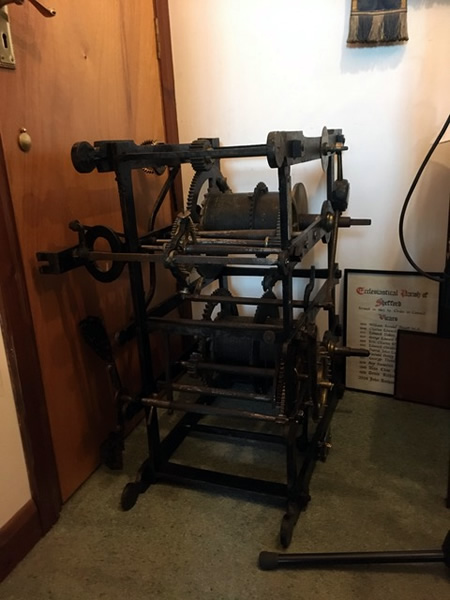
Once the scaffold is down, and the bell (still being restored) is re-installed, the clock can finally start telling and chiming the time for the people of Shefford again.
For some time now we have been talking about how we could make our visitors experience more welcoming, so a new entrance lobby was included in the 'grand plan'.
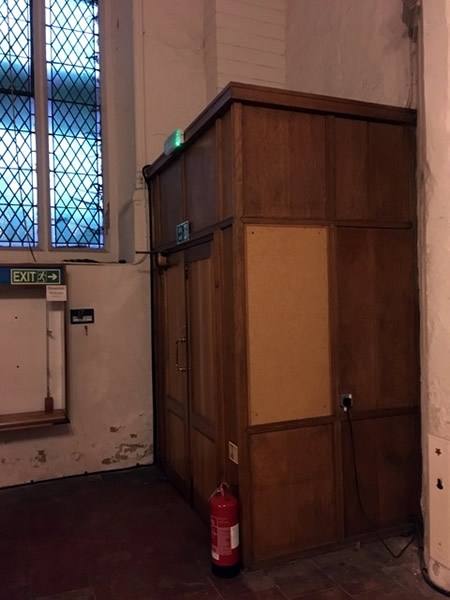
As you can see, the existing entrance lobby is a wooden box with no windows - a dark and unwelcoming space to enter through. By providing a set of inner doors, it did control draughts though.
So, this week, we've taken the first steps in re-modelling this vital 'first impreshions' space. With a big hammer by the looks of it!
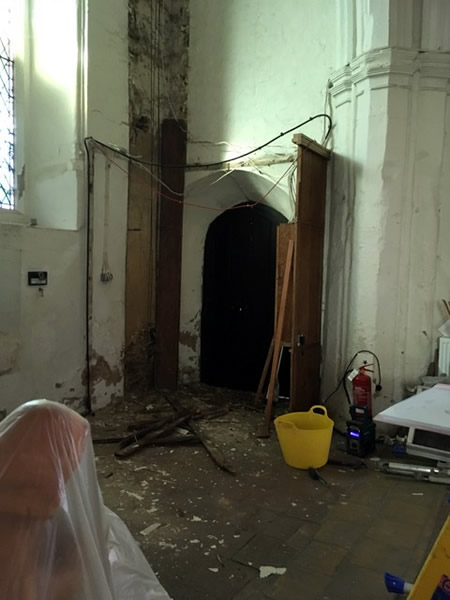
The lobby has been removed, as has the wooden box running down from the bell chamber above, which encased the original steel cables and weights to power the clock (before the more modern electrical winding sytem was installed).
Oh, and whilst all this is going on, we are having our new lighting installed!
We are hoping to be able to re-use some of the wood for a couple of projects we have in mind, but what is the new lobby going to look like?
You'll just have to wait and see...
On Friday February 15th, I was invited to 'go up the tower' to take a look at the work that has been done on our Historic tower. I'm happy to report that the work is nearing completion, and appears to have been done to an extraordinarily high standard.
Of course, none of this would have been possible without the generous support of the Heritage Lottery Fund, All Churches Trust, the Beds & Herts Historic Churches Trust, the Francis Coales Charitable Foundation, and the Steel Charitable Trust.
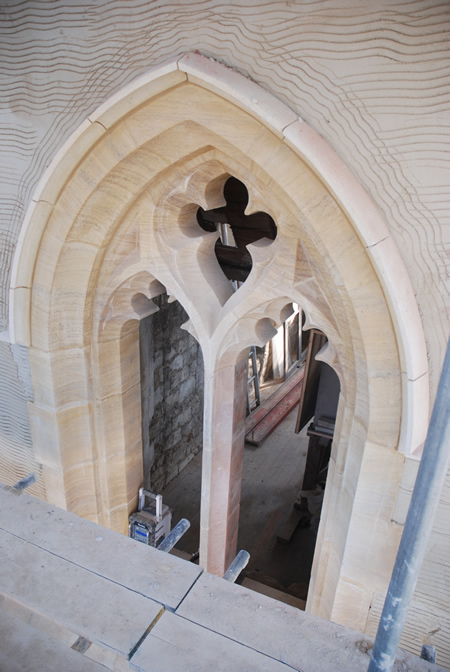
Seeing the beautiful stonework 'in the flesh' was a real privelege - even better than the photos I'd seen.
As the stonework is complete, our builders are now concentrating on the rendering.
The walls have had to be cut back in many places to give a roughly level surface, then stainless steel mesh has been fixed using 100mm screws where they could be made to hold. In some places, the walls were too friable for the screws to hold properly, so stainless steel 'spirals' were inserted and glued into drilled holes, then bent over to anchor the mesh.
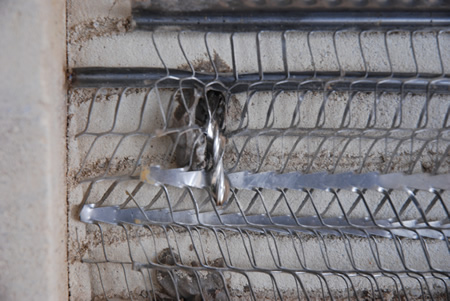
The mesh acts as an anchor for the lime render - two coats are applied. The first is pressed firmly into the mesh so that it squeezes through, making a strong bond.
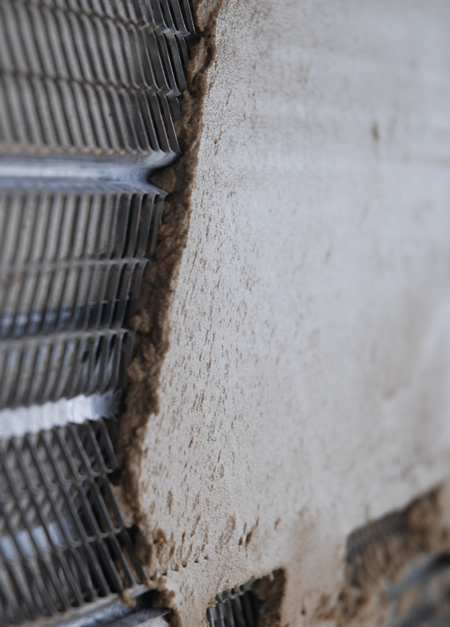
The parapet of the tower is made of brick, which, although sound, did not look right above the new stonework and lime render. It is therefore being rendered to make it tie -in visually with the rest of the tower. The upper stringer course (bottom edge of the parapet) has had lead flashing applied, as removing it to replace it with new stone would probably have resulted in the parapet being damaged to the point of needing to be rebuilt.
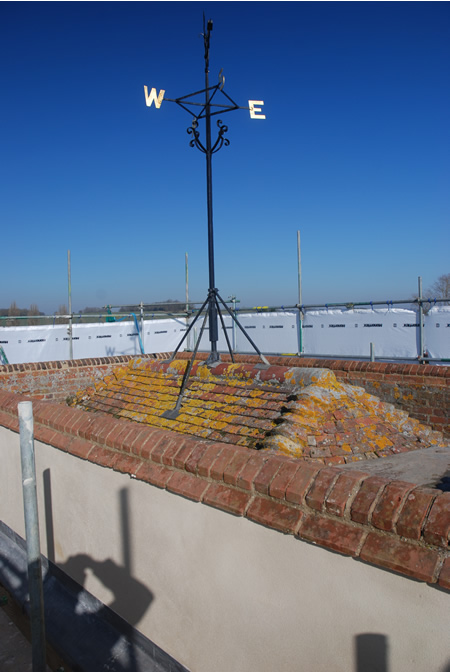
The lower stringer course has been completely replaced with new stone.
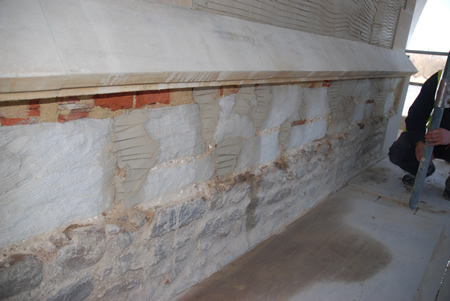
An interesting bit of history was uncovered when the old render was removed - the top south west corner, just below the parapet appears to have had substantial repairs. Two horizontal concrete ring beams were found which seem to have been put in to tie that corner of the tower together. We have no records of when or why this was done. Whoever did the work was not too bothered about accurate measurements though - the tower is significantly 'fatter' on that corner, adding an additional challenge for our builders.
The use of (reinforced) concrete would indicate a fairly recent repair, although the re-bar used appears to be wrought iron bars produced by a blacksmith; certainly nothing like modern re-bar! - The last major restoration of the tower happened just after the First World War when horses and therefore blacksmiths were the order of the day, so this may have happened then.
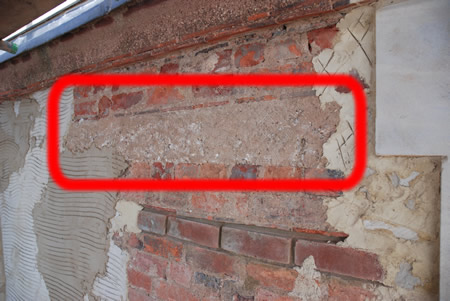
The picture below (pre-dating this visit), shows the iron reinforcing bars uncovered. They have been removed to prevent any future rust damage - the corner has now been properly rebuilt with overlapping stone quoins; the adjacent voids being filled with brick and lime mortar.
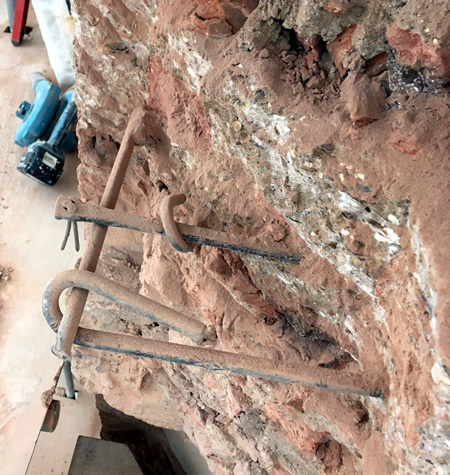
Residents of Shefford may be aware that we have had a bees nest in the west face of the tower for several years - the scaffolding has allowed us to see the opening to the (abandoned) nest for the first time.
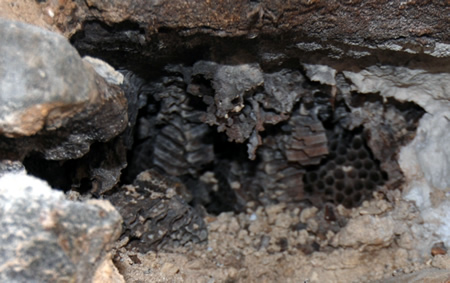
The scaffolding is scheduled to be taken down early in March, so we have around three weeks to finish everything that needs to be done from it. In addition to finishing all of the rendering, the restored clock face and and hands need to be re-fitted, and the flashing between the east face of the tower and the north chancel roof needs to be re-worked.
So, the 'big reveal' should be done before Easter!

Thanks to the generosity of the Heritage Lottery Fund, All Churches Trust, the Beds & Herts Historic Churches Trust, the Francis Coales Charitable Foundation, and the Steel Charitable Trust the new stone windows in our historic Tower are now complete.
As all of the work is largely hidden behind the Monarflex sheeting that the scaffolding is wrapped in, we thought you'd like a sneak peek at what's been going on.
The individual stones were cut off-site using templates produced by our builder. Producing the individual stone components involved a mixture of machine and hand cutting/carving, producing pieces of stone that weighed up to 250KG (a quarter of a ton)!
Each stone had a hole bored in it to allow a 'Lewis Pin' to be inserted. This traditional device, used by the ancient Egyptians, gives a quick and secure anchorage, allowing the stones to be lifted using an electric winch.
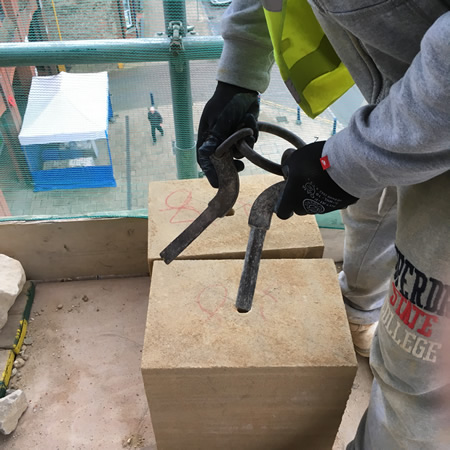
The Lewis Pin before inserting into the bored hole in the stone.
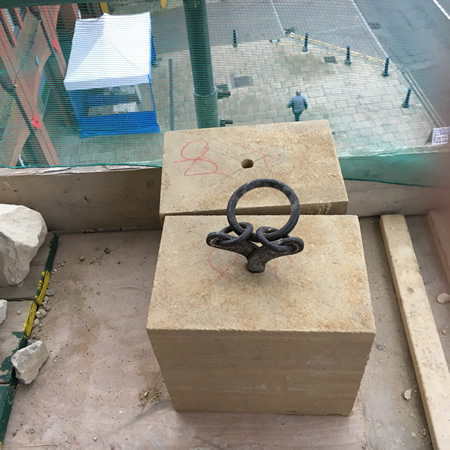
Once inserted, the winch hook is attached to the large iron ring on the top of the tool which splays the legs of the pin outwards in the hole, gripping it firmly.
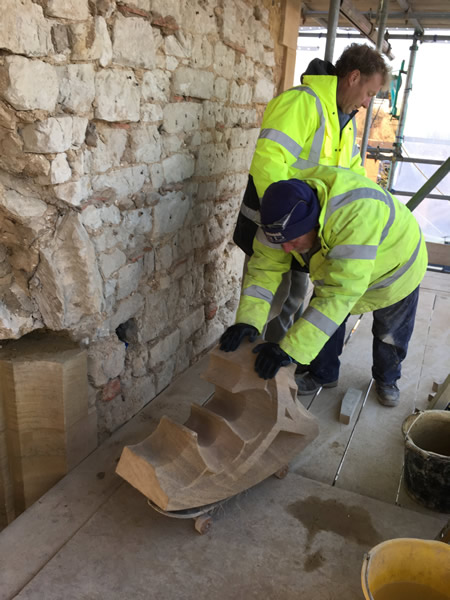
With each stone weighing up to 250KG, moving them into position required some ingenuity - a skateboard provided a practical solution.
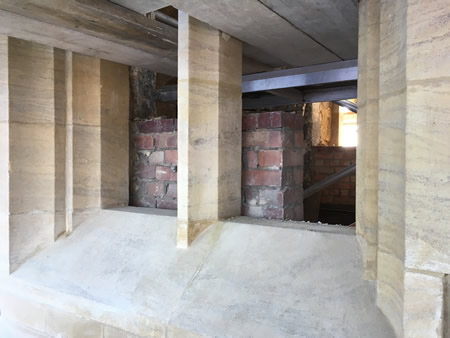
Building the windows required the old, badly weathered stones to be removed one at a time (from the bottom upwards), and replaced with the new Clipsham stone sections. The combination of their weight, and the fact that they were being inserted into slots, rather than just built up on top of each other as would be the case with a new-build, meant that this was a very time consuming process. The picture above shows one of the new cill sections in place with the new frames and tracery being constructed above it.
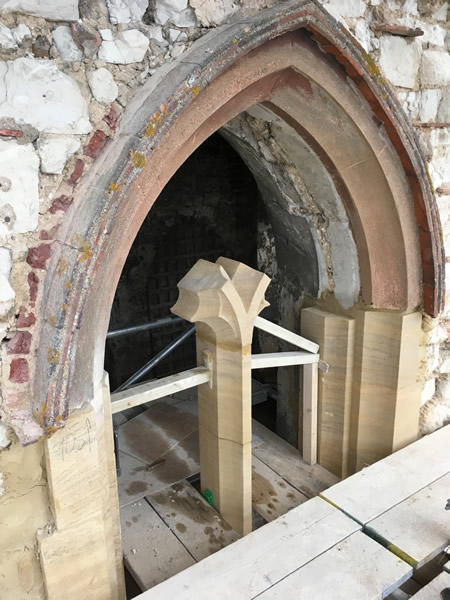
Here you can see the original stone still in place at the top of the window, with the new stone gradually being built up from below. The centre tracery was held in place with timber whilst the lime mortar joining the stones cured.
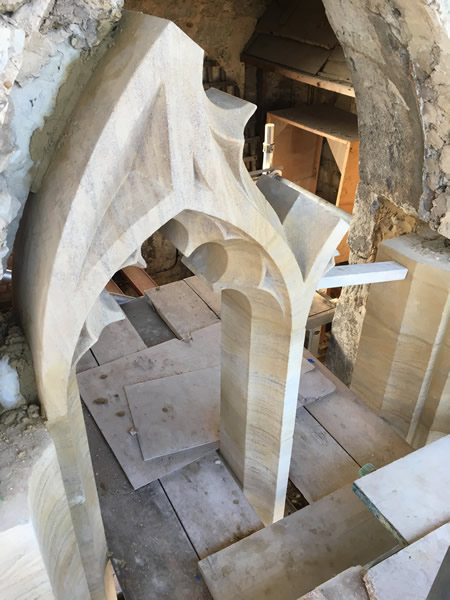
The first window nearing completion...
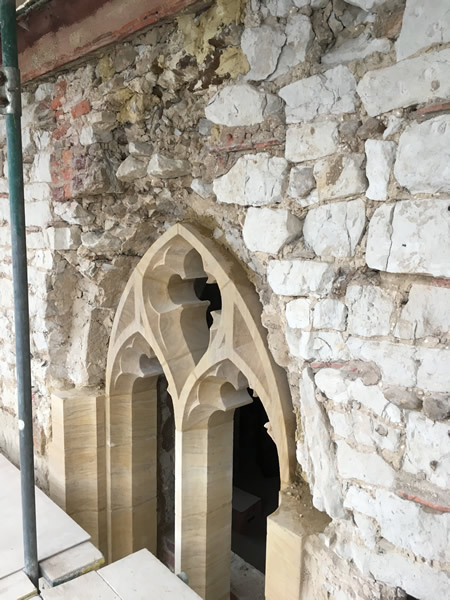
The first window completed, just waiting for the new hood sections to be delivered and fitted. Only three more to go...
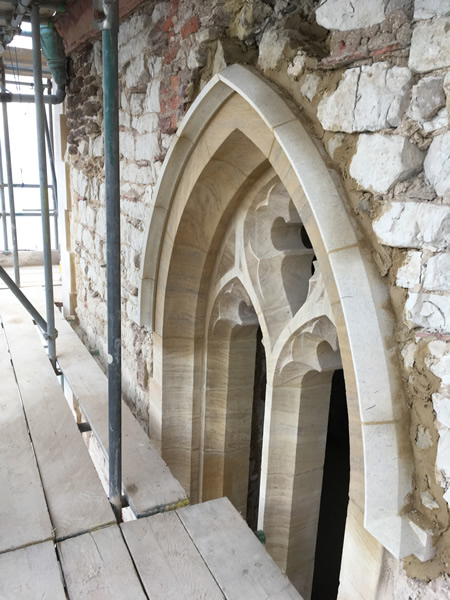
The hood (made from a harder stone to resist weathering) was fitted, completing the first of the four new windows.
Page 9 of 12
